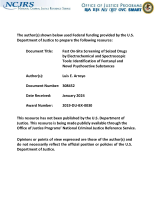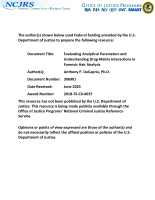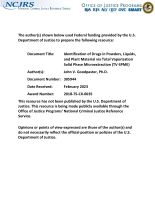Drug research
Patterns of Concordance Between Hair Assays and Urinalysis for Cocaine: Longitudinal Analysis of Probationers in Pinellas County, Florida (From The Validity of Self-Reported Drug Use: Improving the Accuracy of Survey Estimates, P 161-199, 1997, Lana Harrison and Arthur Hughes, eds. - See NCJ 167339)
Modelling Drug Markets
Patterns of Drug Use and Their Relation to Improving Prediction of Patterns of Delinquency and Crime
Assessment of Methods Used by State and Local Governments to Estimate Drug Abuse Levels: Summary
Legal Coercion and Drug Abuse Treatment: Research Findings and Social Policy Implications
Drugs and Crime: Workshop Proceedings
Assessment of Methods Used by State and Local Governments To Estimate Drug Abuse Levels
Assessment of Methods Used by State and Local Governments To Estimate Drug Abuse Levels: Final Report
Fast On-site Screening of Seized Drugs by Electrochemical and Spectroscopic Tools: Identification of Fentanyl and Novel Psychoactive Substances
Remarks By James K Stewart to the New England Council on Crime and Delinquency Prevention, Narragansett, Rhode Island, September 25, 1985
Remarks of James K Stewart Before the Fourth Annual International Symposium on Criminal Justice Issues on September 11, 1989
Opening Remarks by the Honorable James K. Stewart, Director, National Institute of Justice Before the Drug Use Forecasting Advisory Group
Evaluating Analytical Parameters and Understanding Drug-Matrix Interactions in Forensic Hair Analysis
Identification of Drugs in Powders, Liquids, and Plant Material via Total Vaporization Solid Phase Microextraction (TV-SPME)
To Catch a Drug
Assessing the causes of racial disparities in drug courts: An intersectional approach to eliminating barriers to admittance
Results of a Type 2 Translational Research Trial to Prevent Adolescent Drug Use and Delinquency
NIJ Multisite Impact and Cost-Efficiency Evaluation of Veterans Treatment Courts, Fiscal Year 2022
Deadline Notice
The deadline for the funding opportunity discussed in this video has passed.
See the YouTube Terms of Service and Google Privacy Policy
Expanding Research to Examine the Impacts of Forensic Science on the Criminal Justice System
In 2004, the National Institute of Justice created the social science research on forensic sciences (SSRFS) research program to explore the impact of forensic sciences on the criminal justice system and the administration of justice. Much of the early research from the SSRFS program focused on DNA processing and the use of DNA in investigations and prosecutions.
See the YouTube Terms of Service and Google Privacy Policy






